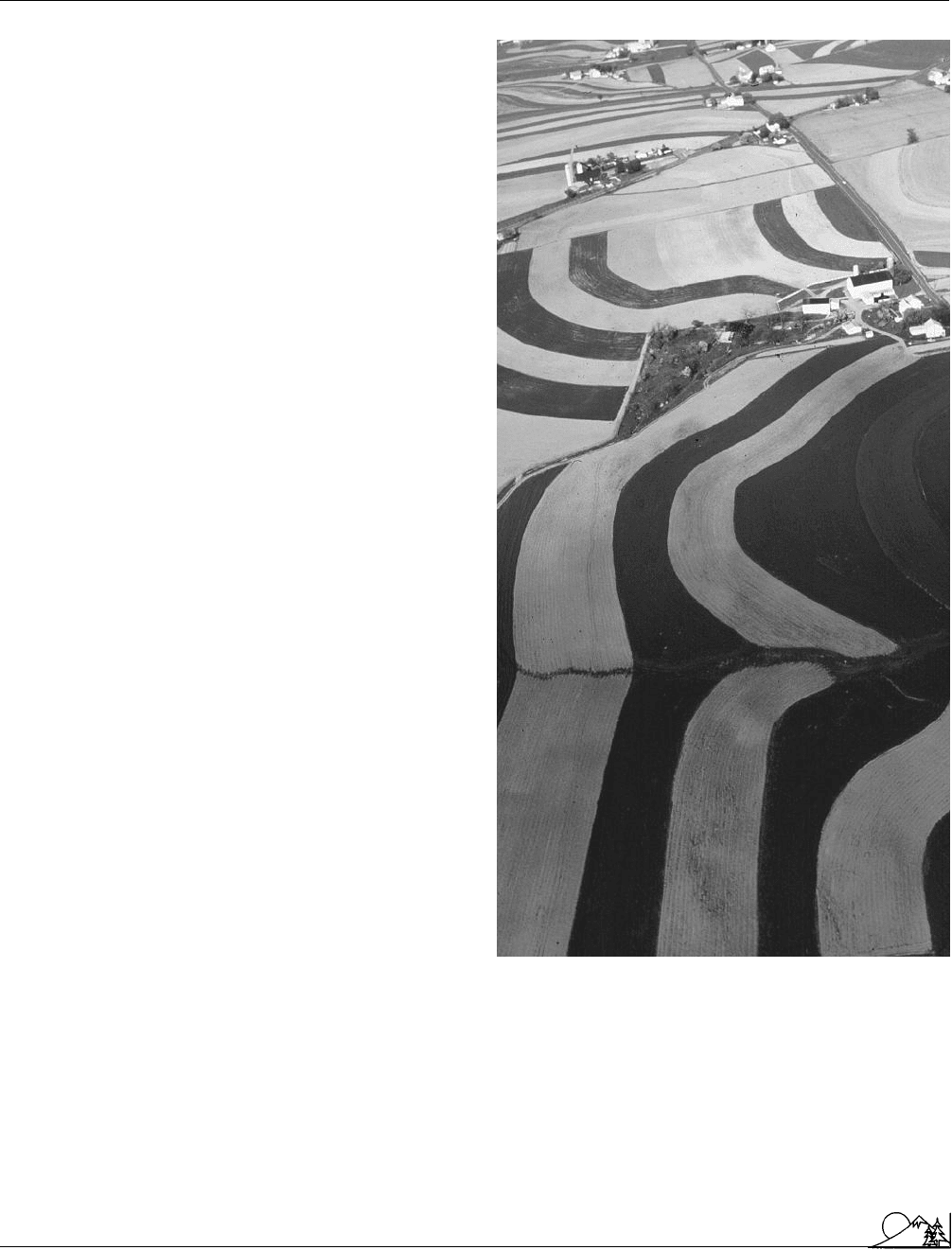Environmental Encyclopedia
Подождите немного. Документ загружается.


Environmental Encyclopedia 3
Conservation biology
biodiversity to include the spatial and temporal changes of
communities on the greater landscape or seascape.
About 1.7 million of Earth’s species have been identi-
fied and given a scientific name. However, biologists have
not yet “discovered” most species, especially those living in
tropical habitats. According to some estimates, Earth may
support as many as 30–50 million species, of which 90%
occur in tropical ecosystems, particularly in old-growth rainf-
orests. Biologists believe that most of the unknown species
are invertebrates, especially species of beetles and other in-
sects. Compared with invertebrates, the numbers of species
of plants and vertebrate animals are relatively well known.
Biodiversity is valuable for many reasons, but these
can be grouped into the following three classes:
(1) Intrinsic value. Regardless of its worth in terms of
the needs of humans, biodiversity has its own,
intrinsic
value
.
(2) Utilitarian value. Humans have an undeniable need
to harvest wild and domesticated species and their communi-
ties as sources of food, materials, and energy. Although
harvests of biodiversity can be conducted in ways that foster
renewal, these potentially renewable resources are often har-
vested or managed too intensively, resulting in degradation
or
extinction
of the resource.
(3) Provision of ecological services. Biodiversity provides
numerous ecological services that are directly and indirectly
important to human welfare. These services include biologi-
cal productivity,
nutrient
cycling, cleansing of water and air,
control of
erosion
, provision of atmospheric oxygen and
removal of
carbon dioxide
, and other functions related to
the health and integrity of ecosystems. According to the
American biologist Peter Raven: “Biodiversity keeps the
planet habitable and ecosystems functional.”
Threats to biological diversity
Biodiversity at local, regional, continental, and global
scales is critically threatened by human activities. The dam-
ages that are being caused to Earth’s species and ecosystems
are so severe that they are referred to by ecologists as a
biodiversity crisis. Many permanent losses of biodiversity
have already been caused by human influences, including the
extinctions of numerous species and the losses of distinctive,
natural communities. Unless there are substantial changes
in the ways that humans affect ecosystems, there will be
enormously greater losses of biodiversity in the near future.
Earth’s natural biodiversity has always been subjected
to extinction (that is, the permanent loss of species and other
groups) The fossil record shows that species, families, and
even entire phyla have appeared and disappeared on Earth.
For example, many invertebrate phyla proliferated during
an evolutionary radiation at the beginning of the Cambrian
307
era about 570 million years ago, but most of these are now
extinct.
Many of the natural extinctions occurred simultane-
ously, apparently as a result of an unpredictable catastrophe.
For instance, about 65 million years ago a
mass extinction
occurred that resulted in the loss of the last of the dinosaurs
and as many as 76% of the then-existing species. That catas-
trophe is believed to have been caused by a meteorite im-
pacting Earth. In other cases, natural extinctions have been
caused by more gradual environmental changes, for example
in climate or in the intensity of disease or predation.
More recently, however, humans have been responsi-
ble for almost all of the extinctions that are occurring. In
fact, species are now being lost so quickly that the changes
represent a modern mass extinction. Well-known examples
of extinctions caused by humans include the
dodo
,
passen-
ger pigeon
, and great auk. Numerous other species have
been taken to the brink of extinction, including the plains
bison
,
whooping crane
,
ivory-billed woodpecker
, and
right whale. These losses have been caused by over-hunting
and the disturbance and conversion of natural habitats.
In addition to these famous cases involving large ani-
mals, an even more ruinous damage to Earth’s biodiversity
is being caused by extensive losses of tropical ecosystems,
particularly the conversion of tropical rain forests into ag-
ricultural habitats. Because tropical ecosystems are particu-
larly rich in numbers of species, loss of natural tropical
habi-
tat
causes extinctions of numerous species. Many of those
species occurred nowhere else but in particular tropical lo-
cales.
The mission of conservation biology is to understand
the causes and consequences of the modern crisis of extinc-
tion and degradation of Earth’s biodiversity, and then to
apply scientific principles to preventing or repairing the dam-
ages. This is largely done by conserving populations and by
protecting natural areas.
Conservation at the population level
In some cases,
endangered species
can be enhanced
by special programs that increase their breeding success and
enhance the survival of their populations. Usually, a variety
of actions is undertaken, along with the preservation of
appropriate habitat, under a scheme that is known as a
population recovery plan. Components of a population re-
covery plan may include such actions as (1) the careful moni-
toring of wild populations and the threats that they face;
(2) research into the specific habitat needs of the endangered
species; (3) the establishment of a captive-breeding program
and the release of surplus individuals into the wild; (4) re-
search into genetic variation within the species; and (5) other
studies of basic biology and ecology that are considered
necessary for preservation of the species, particularly in its
natural habitats. Unfortunately, population recovery plans

Environmental Encyclopedia 3
Conservation easements
have only been developed for a small fraction of endangered
species, and most of these have been prepared for species
that occur in relatively wealthy countries.
One example involves the whooping crane (Grus amer-
icana), an endangered species in North America. Because
of excessive hunting and
critical habitat
loss, this species
declined in abundance to the point where as few as only 15
individuals were alive in 1941. Since then, however, the wild
population of whooping cranes has been vigorously protected
in the United States and Canada, and their critical breeding,
migratory, and wintering habitats have been preserved. In
addition, the basic biology and behaviour of whooping cranes
have been studied, and some wild birds have been taken
into captivity and used in breeding programs to increase the
total population of the species. Some of the captive-bred
animals have been released to the wild, and whooping crane
eggs have also been introduced into the nests of the closely
related sandhill crane (Grus canadensis), which serve as foster
parents. These applications of conservation biology have
allowed the critically endangered population of whooping
cranes to increase to more than 150 individuals in the mid-
1980s, and to about 300 birds in 1997, of which about half
were in captivity. Because of these actions, there is now
guarded optimism for the survival of this endangered species.
Protected areas
Protected areas such as parks and ecological reserves
are necessary for the conservation of biodiversity in wild,
natural ecosystems. Most protected areas are established for
the preservation of natural values, particularly the known
habitats of endangered species, threatened ecological com-
munities, or representative examples of widespread commu-
nities. However, many protected areas (particularly parks)
are also used for human activities, as long as they do not
severely threaten the ecological values that are being con-
served. These uses can include
ecotourism
, and in some
cases fishing, hunting, and even timber harvesting. In 1993
there were about 9,000 protected areas globally, with a total
area of almost two million acres (792 million ha). Of this
total, about 2,500 sites comprising 1.15 million acres (464
million ha) were fully protected, and could be considered to
be ecological reserves.
Ideally, a national system of protected areas would
provide for the longer-term conservation of all native species
and their natural communities, including terrestrial, freshwa-
ter, and marine ecosystems. So far, however, no country has
implemented a comprehensive system of ecological reserves
to fully protect the natural biodiversity of the region. More-
over, many existing reserves are relatively small and are
threatened by environmental changes and other distur-
bances, such as illegal hunting of animals and plants and
sometimes intensive tourism.
308
Ecological knowledge has allowed conservation biolo-
gists to make important contributions to the optimized de-
sign of networks of protected areas. Important considerations
include: (1) the need to protect areas that provide adequate
representation of all types of natural ecosystems; (2) the need
to preserve all endangered ecosystems and the habitats of
threatened species; (3) the requirement of redundancy, so
that if one example of an endangered
ecosystem
becomes
lost through an unavoidable natural disturbance (such as a
hurricane
or
wildfire
), the type will continue to survive in
another protected area; (4) the need to decide whether or
not the network of protected areas should be linked by
corridors, a matter of some controversy among ecologists.
Conservation biology has also made important contri-
butions towards the spatial design of individual protected
areas. Important considerations include (1) the need to make
protected areas as large as possible, which will help to allow
species and ecosystems to better cope with disturbances and
environmental changes; (2) a preference for smaller reserves
to have a minimal amount of edge, which helps to avoid
damages that can be caused by certain predators and invasive
species; (3) the need to take an ecosystem approach which
ensues that the reserve and its surrounding area will be
managed in an integrated manner.
Although conservation biology is a relatively young
field, important progress is being made towards development
of the effective ecological and biological tools necessary to
preserve biodiversity.
[Bill Freedman Ph.D.]
R
ESOURCES
B
OOKS
Freedman, B. Environmental Ecology, 2nd edition. Academic Press, San
Diego, 1995.
Primack, R.B. Essentials of Conservation Biology. Sunderland, MA: Sinauer
Associates, 1993.
Wilson, E.O. (ed.). Biodiversity. Washington, D.C: National Academy
Press, 1988.
Conservation design
see
Urban sprawl
Conservation easements
A
conservation
easement is a covenant, restriction, or
condition in a deed, will, or other legal document that allows
the owner to maintain ownership and control of real prop-
erty, but restricts the use of that property so the land is
conserved in its natural state, or, in the case of a historic
conservation easement, so that it provides a historic benefit.

Environmental Encyclopedia 3
Conservation Reserve Program
The uses allowed by the easement can include
recreation
,
agriculture, cultural uses, and establishment of
wildlife hab-
itat
. The federal government allows tax deductions for con-
servation easements that provide a certified value to the
public, such as protecting ecologically valuable natural habi-
tat or, in the case of an easement based on the historical
conservation of the property, that contribute to the historic
character of the district in which the property is located.
Conservation easements are legal instruments enabled by
many states as well as non-United States governments, in-
cluding Canada and most of its provinces.
[Marie H. Bundy]
Conservation International
Conservation International (CI) is a non-profit, private orga-
nization dedicated to saving the world’s endangered rain
forests and the plants and animals that rely on these habitats
for survival. CI is basically a scientific organization, a fact
which distinguishes it from other conservation groups. Its
staff includes leading scientists in the fields of botany, orni-
thology, herpetology, marine biology, entomology, and zo-
ology.
Founded in 1987 when it split off from
the Nature
Conservancy
, CI now has over 55,000 members. The
group, headed by Peter A. Seligmann, has gathered accolades
since its inception. In 1991 Outside Magazine gave CI an
A- (one of the two highest grades received) in its yearly
report card rating 14 leading environmental groups.
The high praise is well founded. CI tends to success-
fully implement its many projects and goals. Many CI pro-
grams focus on building local capacity for conservation in
developing countries through financial and technical support
of local communities, private organizations, and government
agencies. Their “ecosystem conservation” approach balances
conservation goals with local economic needs. CI also funds
and provides technical support to local communities, private
organizations, and government agencies to help build sus-
tainable economies while protecting
rain forest
ecosystems.
Four broad themes underlie all CI projects: 1) a focus
on entire ecosystems; 2) integration of economic interests
with ecological interests; 3) creation of a base of scientific
knowledge necessary to make conservation-minded deci-
sions; and 4) an effort to make it possible for conservation
to be understood and implemented at the local level.
CI is involved with projects in 30 countries, including
Botswana, Brazil, Canada, Colombia, Indonesia, Mexico,
New Guinea, and the Philippines. In 2000, CI expanded
into Cambodia and China, among others.
Among CI’s many successful projects is the Rapid
Assessment Program (RAP), which enlists the world’s top
309
field scientists to identify
wilderness
areas in need of urgent
conservation attention. RAP teams have completed surveys
in Bolivia, Ecuador, Belize, Peru, and Mexico, and CI plans
at least 12 more surveys on four continents in the next
three to five years. CI has also helped establish important
biosphere
reserves in rain forest countries. These efforts
successfully demonstrate CI’s
ecosystem
conservation ap-
proach, and prove that the economic needs of local commu-
nities can be reconciled with conservation needs. No harvest-
ing or
hunting
is allowed in the reserves, but
buffer
zones,
which include villages and towns, are located just outside
the core areas.
CI strongly supports many educational programs. In
1988, it signed a long-term assistance agreement with Stan-
ford University which involves exchange and training of
Costa Rican students and resource managers. In 1989 CI
began a program with the University of San Carlos which
provides financial and technical support to the research activ-
ities in northern Guatemala of the university’s Center for
Conservation Studies. An educational program of a different
kind, the Sorcerer’s Apprentice, is designed to record ethno-
botanical knowledge, protect useful
species
, and pass this
information on to the next generation in indigenous commu-
nities. Young men and women in forestry services learn from
traditional village healers and midwives.
In 2002, CI has already established several new ways
to educate the people and help the
environment
, such as
Centers for
Biodiversity
Conservation, the Global Conser-
vation Fund, and a joint venture with Ford Motor Company
called the Center for Environmental Leadership in Business.
CI also focuses on activities in the major wilderness areas
identified as the most endangered. The organization also
has expanded its conservation efforts to new ecosystems,
including marine,
desert
, and temperate rain forest regions.
[Cathy M. Falk]
O
RGANIZATIONS
Conservation International, 1919 M Street, NW Suite 600, Washington,
D.C. USA 20036 (202) 912-1000, Toll Free: (800) 406-2306, Email:
inquiry@conservation.org, <http://www.conservation.org>
Conservation Reserve Program
The Conservation Reserve Program (CRP) is a voluntary
program for agricultural landowners, that encourages farmers
to plant long-term resource-conserving vegetative ground
cover to improve
soil
and water, and create more suitable
habitat
for fish and
wildlife
. Ground cover options include
grasses, legumes, shrubs, and tree plantings. The program
is authorized by the federal Food Security Act of 1985,
as amended, and is implemented through the Commodity

Environmental Encyclopedia 3
Conservation Reserve Program
Credit Corporation (CCC). It aims to promote good
land
stewardship
and improve rural aesthetics.
The CRP offers annual rental payments, incentive
payments, and cost-share assistance to establish approved
cover on eligible cropland. The CCC provides assistance of
as much as 50% of the landowner’s cost in establishing an
approved conservation program. Contracts remain in effect
for between 10 and 15 years. Annual rental payments are
based on the agriculture rental value of the land used in the
program. The program provides needed income support for
farmers, and helps to curb production of surplus commod-
ities.
Eligibility for participation in CRP extends to individ-
uals, partnerships, associations, Indian tribal ventures corpo-
rations, estates, trusts, other business enterprises or legal
entities. States, political subdivisions of states, or agencies
thereof owning or operating croplands, may also apply.
The CCC via the Farm Service Agency (FSA) man-
ages the CRP. The Natural Resources Conservation Service
(NRCS) and the Cooperative State Research and Education
Extension Service provide support. State forestry agencies
and local soil and
water conservation
districts also provide
assistance.
To be eligible for the CRP, cropland should have been
planted or considered planted to an agricultural commodity
in two of the five most recent crop years. Eligibility encom-
passes highly
erodible
acreage, cropped
wetlands
, and land
surrounding non-cropped wetlands. The cropland must be
owned or operated for at least 12 months before the close
of the sign-up period. Exceptions can be made for land that
was acquired by will or
succession
, or if the FSA determines
that ownership was not acquired for the purpose of placing
the land in the conservation reserve.
Initially,
erosion
reduction was the sole criterion for
acceptance in the CRP, and in 1986–87, 22 million acres
(8.9 million ha) were enrolled for this purpose. CRP proved
to be effective. According NRCS
statistics
, average erosion
on enrolled acres declined by about 90%. It was estimated
that the program reduced overall erosion nationwide by more
than 22% even though less than 10% of the nation’s cropland
was enrolled.
An Environmental Benefits Index (EBI) is used to
prioritize applications for the CRP. EBI factors include:
Wildlife habitat benefits,
water quality
benefits from re-
duced erosion,
runoff
, and
leaching
, and
air quality
bene-
fits from reduced wind erosion. The NRCS collects data for
each of the factors and, based on its analysis, applications
are ranked. Selections are made from that ranking.
The CCC bases rental rates on the productivity of
soils within a county, and the average rent for the past three
years of local agricultural land. The maximum CRP rental
rate for each applicant is calculated in advance of enrollment.
310
Applicants may accept that rate, or may offer a lower rental
rate to increase the likelihood that their project will be
funded.
The CCC encourages restoration of wetlands by pro-
viding a 25% incentive payment of the costs involved to
establish approved cover. This is in addition to the normal
50% cost share for non-wetlands. Eligible acreage devoted
to special conservation practices, such as riparian buffers,
filter strips, grassed waterways, shelter belts, living snow
fences, contour grass strips, salt tolerant vegetation, and
shallow water areas for wildlife, may be enrolled at any time
and is not subject to competitive bidding.
When CRP contracts expire, participants must con-
tinue to follow approved conservation plans. They must
comply with wetland,
endangered species
and other fed-
eral, state, and local environmental laws, and they must
respect any continuing conservation easement on the
property.
The United States Department of Agriculture
(USDA) provides information and technical assistance to
CRP participants who wish to return CRP land to row-
crop producing status as their contracts expire. This is to
ensure that the land is developed in a sound, productive, and
sustainable manner, preventing excessive erosion, protecting
water quality, and employing other measures that enhance
soil moisture-retaining ability.
In states such as North Dakota, the landscape has
been changed dramatically since the introduction of the
CRP. In the 1970s and early 1980s, fields with steep hills
and areas of light soil were often cultivated from fencerow-
to-fencerow. The result often was severe erosion and perma-
nent loss of soil fertility. In some areas, winters were domi-
nated by “snirtstorms” when a combination of dirt and snow
blew across the landscape depositing a dark coating on coun-
tryside downwind. In contrast, today’s travelers find these
landscapes covered with green vegetation in summer and
white snow in winter.
The CRP has particularly benefited migratory birds
in states such as North Dakota, South Dakota, and Montana.
The perennial vegetation on marginal farmland has provided
refuge for migrating birds, and added breeding habitat for
others. North Dakota farmers have enrolled about 10% of
the state’s cropland in the CRP.
The fiscal year 2000 federal agricultural appropriations
bill authorized a pilot project of harvesting of
biomass
from
CRP land to be used for energy production. Six projects
were authorized, no more than one of which could be in
any state. Vegetation could not be harvested more often than
once every two years, and no commercial use could be made
of the harvested biomass other than energy production. An-
nual CRP rental payments are reduced by twenty five percent
during the year the acreage is harvested. Land that is devoted

Environmental Encyclopedia 3
Conservation Reserve Program
to field windbreaks, waterways, shallow water ways for wild-
life, contour grass strips, shelter belts, living snow fences,
permanent vegetation to reduce
salinity
, salt tolerant vegeta-
tive cover, filter strips, riparian buffers, wetland restoration,
and cross-wind trap strips is not eligible for this program.
By 2002, contracts had been approved in Iowa, Illinois,
Oklahoma, Minnesota, New York, and Pennsylvania.
In June of 2001, the USDA announced a six-state
pilot program as part of the CRP to restore up to 500,000
acres (202,000 ha) of farmable wetlands and associated buff-
ers. The Farmable Wetlands Pilot Program is intended to
help producers improve the
hydrology
and vegetation of
eligible land in Iowa, Minnesota, Montana, Nebraska, North
Dakota, and South Dakota. Restoring wetlands in these
states should reduce downstream flood damage, improve
surface and
groundwater
quality, and recharge ground-
water supplies. Essential habitat for migratory birds and
many other wildlife
species
, including threatened and en-
dangered species will be created and enhanced. Recreational
activities such as hiking and bird watching will also be im-
proved.
In 1985, the year in which CRP originated, spring
surveys by the U.S
Fish and Wildlife Service
estimated
waterfowl breeding populations at 25.6 million ducks. A fall
flight of 54.5 million was predicted. Several species of ducks
including mallards, pintails, and blue-winged teal appeared
to be fading away. Numbers were at or near their lowest
ebb in 30 years. Between 1986 and 1990, farmers enrolled
8.2 million acres (3.3 million hectare) of cropland in CRP
within an area known as the
prairie
pothole region. This
large glaciated area of the north central United States and
southern Canada is where up to 70% of North America’s
ducks are hatched. Through CRP, nearly 13,000 mi
2
(34,000
km
2
) was converted to superior nesting habitat through
CRP.
In the early 1990s, increased precipitation filled the
prairie potholes and many waterfowl ended their spring
mi-
gration
on CRP land, rather than continuing migration to
their usual breeding grounds in Canada. Nesting densities
increased many fold. Potholes surrounded by CRP grass
provided more secure habitat for nests, and hatchlings were
no longer easy targets for predators. Nesting success tripled,
from 10 to 30%, and waterfowl
mortality
no longer exceeded
annual additions. By 1995, ten years after the start of CRP,
36.9 million ducks were included in the annual spring survey
numbers, a 40% increase in 10 years.
Waterfowl are not the only bird species to benefit from
CRP. In one study, breeding birds were counted in about
400 fields in eastern Montana, North and South Dakota,
and western Minnesota. These states have nearly 30% of all
land included in the CRP. Fields were planted mostly to
mixtures of native and introduced grasses and legumes. For
311
most of the seventy-three different species counted, numbers
were far higher in CRP fields than in cropland. Differences
were greatest for several grassland species whose numbers
had been markedly declining in recent surveys. Two species,
lark buntings (Calamospiza melanocorys ) and grasshopper
sparrows (Ammodramus savannarum ), were 10 and 16 times
more common in CRP
environment
than in cropland. The
investigators concluded that restoration of suitable habitat
in the form of introduced grasses and legumes can have an
enormous beneficial effect on populations of grassland birds.
When CRP was due to expire in 1995, restoration of
prairie pothole breeding grounds was in jeopardy. United
States farm policy was undergoing major change and it ap-
peared that the CRP would not be continued.
Ducks Unlim-
ited
and other wildlife organizations lobbied heavily, and
funding of one billion dollars was included in the 1996
Farm Bill to continue the program for another seven years.
Moreover, the guidelines for the continuing program were
geared more directly to the preservation of wetlands and
waterfowl conservation. The prairie pothole region was des-
ignated a national conservation priority area, and during the
March 1997 sign-up more acres in the prairie pothole region
were enrolled in CRP than were due to expire.
In its first 10 years, the CRP cost nearly $2 billion
per year. Opponents have argued that this is too expensive,
while proponents maintain that the costs are offset by its
conservation and environmental benefits. Estimates of the
annual value of benefits range from slightly less than $1
billion to more than $1.5 billion. Some analysts claim that
the value of benefits approaches or exceeds costs in some
sites.
The USDA announced that there would not be general
CRP signup for Fiscal Year 2002 although producers could
continue to enroll acreage eligible under continuous enroll-
ment provisions. Later, they announced that CRP contracts
expiring in 2002 could be extended for another year.
[Douglas C. Pratt Ph.D.]
R
ESOURCES
P
ERIODICALS
2002 Ducks Unlimited, Inc. May 31, 2002 [June 2002]. <http://www.duck-
s.org/conservation/crp.asp>.
Conservation Reserve Program Biomass Pilot Projects. U.S. Department of
Agriculture, Farm Service Agency Online. Fact Sheet Electronic Edition.
November 2000 [May 2002].
Kantrud, Harold A., Rolf R. Koford, Douglas H. Johnson, and Michael
D. Schwartz.” The Conservation Reserve Program—Good for Birds of
Many Feathers.” North Dakota Outdoors 56, no. 2: 14–17.
Johnson, D. H., and M. D. Schwartz. “The Conservation Reserve Program
and Grassland birds.” Conservation Biology 7: 934–937.
New Conservation Reserve Program The University of Georgia, Cooperative
Extension Service Extension, Forest Resources Unit. FOR. 97-003. 1997
[May 2002].

Environmental Encyclopedia 3
Conservation tillage
USDA To Help Restore Wetlands Through Six-state Pilot Programs. Farm
Service Agency Public Affairs Staff June 4, 2001 [June 2002].
Conservation tillage
Conservation
tillage is any
tilth
sequence that reduces loss
of
soil
or water in farmland. It is often a form of non-
inversion tillage that retains significant amounts of plant
residues on the surface. Thirty percent of the soil surface
must be covered with plant residues at crop planting time
to qualify as conservation tillage under the Conservation
Technology Information Center definition. Other forms of
conservation tillage include ridge tillage, rough plowing, and
tillage that incorporates plant residues in the top few inches
of soil.
A number of implements for primary tillage are used
to retain all or a part of the residues from the previous crop
on the soil surface. These include machines that fracture the
soil, such as chisel plows, combination chisel plows, disk
harrows, field cultivators, undercutters, and strip tillage ma-
chines. In a no-till system, the soil is not disturbed before
planting. Most tillage systems that employ the moldboard
plow are not considered conservation tillage because the
moldboard plow leaves only a small amount of residue on
the soil surface (0–10%).
When compared with conventional tillage (moldboard
plow with no residue on the surface), various benefits from
conservation tillage have been reported. Chief among the
benefits are reduced wind and water
erosion
and improved
water conservation
. Erosion reductions from 50–90% as
compared with conventional tillage are common. Conserva-
tion tillage often relies on herbicides to help control weeds
and may require little or no post-planting cultivation for
control of weeds in row crops. Depending on the manage-
ment system used,
herbicide
amounts may or may not be
greater than the amounts used on conventionally tilled land.
Yields from conservation tillage, particularly corn, may be
greater or smaller than from conventional tilled soil. Crop
yield problems are most frequent on wet soils in the northern
United States. Costs of tillage may be lower, but not always,
from conservation tillage as compared with conventional.
[William E. Larson]
R
ESOURCES
B
OOKS
Little, C. E. Green Fields Forever: The Conservation Tillage Revolution in
America. Covelo, CA: Island Press, 1987.
312
Consultative Group on International
Agricultural Research
The Consultative Group on International Agricultural Re-
search (CGIAR) was founded in 1971 to improve food
production in developing countries. Research into agricul-
tural productivity and the management of
natural re-
sources
are the two goals of this organization, and it is
dedicated to making the scientific advances of industrialized
nations available to poorer countries. The CGIAR empha-
sizes the importance of developing sustainable increases in
agricultural yields and creating technologies that can be used
by farmers with limited financial resources.
Membership consists of governments, private founda-
tions, and international and regional organizations. The
goals of this association are carried out by a network of
International Agricultural Research Centers (IARCs). There
are currently 18 such centers throughout the world, all but
four of them in developing countries, and they are each
legally distinct entities, over which the CGIAR has no direct
authority. The group has no constitution or by-laws, and
decisions are reached by consensus after consultations with
its members, either informally or at their semiannual meet-
ings. The function of the CGIAR is to assist and advise the
IARCs, and to this end it maintains a Technical Advisory
Committee (TAC) of scientists who review ongoing research
programs at each center.
Each IARC has its own board of trustees as well as
its own management, and they formulate individual research
programs. The research centers pursue different goals, ad-
dressing problems in a particular sector of agriculture, such
as livestock production or agricultural challenges in specific
parts of the world, such as crop production in the semi-arid
regions of Africa and Asia. Some centers conduct research
into integrated plant protection, and others into forestry,
while some are more concerned with policy issues, such as
food distribution and the international food trade. One of
the priorities of the CGIAR is the
conservation
of seed and
plant material, known as germplasm, and the development of
policies and programs to ensure that these resources are
available and fully utilized in developing countries. The In-
ternational Board for Plant Genetic Resources is devoted
exclusively to this goal. Besides research, the basic function
of the IARCs is educational, and in the past two decades
over 45,000 scientists have been trained in the CGIAR
system.
The central challenge facing the CGIAR is world
population growth
and the need to increase agricultural
production by nearly 50% in the next 20 years while preserv-
ing natural resources. The group was one of the main con-
tributors to the so-called “Green Revolution.” It helped de-
velop new high-yielding varieties of cereals and introduced

Environmental Encyclopedia 3
Container deposit legislation
them into countries previously unable to grow the food;
some of these countries now have agricultural surpluses. In
2001, CGIAR in South Africa worked on developing two
new types of maize, which have a 30–50% larger crop than
what is currently being produced by the smaller farmers.
The CGIAR is working to increase production even further,
narrowing the gap between actual and potential yields, while
continuing its efforts to limit
soil erosion
,
desertification
,
and other kinds of
environmental degradation
.
The
World Bank
, the Food and Agriculture Organi-
zation (FAO) and the United Nations Development Pro-
gram (UNDP) are among the original sponsors of the
CGIAR, and the organization has its headquarters at the
offices of the World Bank, which also funds central staffing
positions. Combined funding has grown from $15 million
in 1971 to over $340 million in 1999, and the CGIAR has
a staff of 12,000 worldwide. The group publishes a newsletter
called CGIAR Highlights.
[Douglas Smith]
R
ESOURCES
O
RGANIZATIONS
CGIAR Secretariat, The World Bank, MSN G6-601, 1818 H Street NW,
Washington, D.C. USA 20433 (202) 473-8951, Fax: (202) 473-8110,
Email: cgiar@cgiar.org, <http://www.cgiar.org>
Container deposit legislation
Container deposit legislation requires payment of a deposit
on the sale of most or all beverage containers and may require
that a certain%age of beverage containers be allocated for
refillables. The legislation shifts the costs of collecting and
processing beverage containers from local governments and
taxpayers to manufacturers, retailers and consumers.
While laws vary from state to state, even city to city,
container deposit legislation generally provides a monetary
incentive for returning beverage cans and bottles for
recycl-
ing
. Distributors and bottlers are required to collect a deposit
from the retailer on each can and bottle sold. The retailer
collects the deposit from consumers, reimbursing the con-
sumer when the container is returned to the store. The
retailer then collects the deposit from the distributor or
bottler, completing the cycle. Consumers who choose not
to return their cans and bottles lose their deposit, which
usually becomes the property of the distributors and bottlers,
though in some states, unredeemed deposits are collected
by the state.
Oregon implemented the first deposit law or “bottle
bill” in 1972. In the 1970s and 1980s, industry opponents
fought container deposit laws on the grounds that they would
result in a loss of jobs, an increase in prices, and a reduction
313
in sales. Now opponents denounce the legislation as being
detrimental to curbside recycling programs. But over the
past two decades, container deposit legislation has proven
effective not only in controlling litter and conserving
natural
resources
but in reducing the
waste stream
as well.
Recovery rates for beverage containers covered under
the deposit system depend on the amount of deposit and the
size of the container. The overall recovery rate for beverage
containers ranges from 75 to 93%. The reduction in con-
tainer litter after implementation of the deposit law ranges
from 42 to 86%, and reduction in total volume ranges from
30 to 60%. Although beverage containers make up just over
5% by weight of all
municipal solid waste
generated in
the United States, they account for nearly 10% of all waste
recovered, according to the
Environmental Protection
Agency
(EPA). While the cans and bottles that are recycled
into new containers or new products ease the burden on the
environment
, recycling is a second-best solution.
As recently as 1960, 95% of all soft drinks and 53%
of all packaged beer was sold in refillable glass bottles. Those
bottles required a deposit and were returned for
reuse
20
or more times. But the centralization of the beverage indus-
try, the increased mobility of consumers, and the desire
for convenience resulted in the virtual disappearance of the
reusable beverage container. Today, refillables make up less
than 6% by volume of packaged soft drinks and 5% by
volume of packaged beer, and these percentages shrink every
year, according to the National Soft Drink Association and
the Beer Institute.
Reuse is a more environmentally responsible
waste
management
option, and is superior to recycling in the
waste reduction
hierarchy established by the EPA. While
the container industry has been unwilling to promote refill-
able bottles, new interest in container deposit legislation may
move industries and governments to adopt reuse as part of
their waste management practices.
Industry-funded studies have found that a refillable
glass bottle used as few as eight times consumes less energy
than any other container, including recycled containers. A
study conducted for the National Association for Plastic
Container Recovery found that the 16-oz (1 pt) refillable
bottle produces the least amount of waterborne waste and
fewest atmospheric emissions of all container types.
To date, 10 states and one city have enacted beverage
container deposit systems, designed to collect and process
beverage bottles and cans. A deposit of 5–10 cents per can
or bottle is an economic incentive to return the container.
The states that have some form of container deposit legisla-
tion and accompanying deposit system include Oregon, New
York, Connecticut, Maine, Iowa, Vermont, Michigan, Mas-
sachusetts, Delaware, and California. Legislation is pending
in 25 state legislatures, and on
Earth Day
1993, a national

Environmental Encyclopedia 3
Contaminated soil
bottle bill was introduced in the U.S. Congress by sponsors
from the House of Representatives.
Despite the fact that opinion polls show the public
supports bottle bills by a nearly three-to-one margin, for
two decades the beverage and packaging industries have
successfully blocked the passage of bottle bills in nearly 40
states and even the most successful container deposit pro-
grams have come under attack and are threatened with
repeal.
Connecticut has one of the highest percentages of
refillable beer bottles in the nation, according to
statistics
from the Beer Institute. Despite the success of the state’s
five-cents-per-container deposit legislation, Governor Low-
ell Weicker Jr. has pushed for repeal of the legislation, to
be replaced by a five-cents-per-container tax to benefit the
state parks system. Opponents to Weicker’s plan insist that
the repeal of the deposit law would result in greater numbers
of bottles and cans left strewn across the state.
Others predict the repeal of the bottle bill would im-
pact the state in other ways: about 1,000 jobs would be lost;
small redemption centers would go out of business; and
recycling rates for glass,
aluminum
and plastic would drop.
In addition, it has been estimated that repeal would cost
municipal curbside recycling programs in Connecticut be-
tween $5.4 and $12.5 million annually.
The United States has a long way to go to catch up
to progressive countries such as Sweden, which does not
allow aluminum cans to be manufactured or sold without
industry assurances of a 75% recycling rate. Concerned that
voluntary recycling would not meet these standards, the
beverage, packaging and retail industries in Sweden have
devised a deposit-refund system to collect used aluminum
cans. Consumers in Sweden return their aluminum cans at
a rate that has not been achieved in any other country. The
75% recycling rate was achieved in 1987, and industry experts
expect the rate to exceed 86% in 1993. Most North American
deposit systems rely on the distributor or bottler, but the
deposit in Sweden originates with the can manufacturer or
drink importer delivering cans within the country. Also,
retail participation is voluntary: retailers collect the deposit
but are not required to redeem the containers, though
most do.
In 1991, 122 billion containers, weighing about 7.2
million tons, were produced in the United States—a 100%
increase in packaging waste since 1960. Containers and
packaging are the single largest component of the waste
stream and they offer the greatest potential for reduction,
reuse, and recycling, according to the EPA. Where individu-
als, industries, and governments will not voluntarily comply
with recycling programs, container deposit legislation has
314
decreased the amount of
recyclables
entering the waste
stream.
[Linda Rehkopf]
R
ESOURCES
P
ERIODICALS
Franklin, P. “Sweden’s Aluminum Can Return System.” Resource Recycling
(March 1993): 66.
Langer, G. “Many Happy Returns.” Sierra 73 (March-April 1988): 19-22.
Williams, T. “The Metamorphosis of Keep America Beautiful.” Audubon
92 (March 1990): 124-133.
Containment structures
see
Nuclear power
Contaminated soil
The presence of pollutants in soils at concentrations above
background levels that pose a potential health or ecological
risk. Soils can be contaminated by many human actions
including the
discharge
of solids and liquid pollutants at
the
soil
surface;
pesticide
application; subsurface releases
from leaks in buried tanks, pipes, and landfills; and deposi-
tion of atmospheric contaminants such as dusts and particles
containing
lead
. Common contaminants include volatile
hydrocarbons—such as
benzene
,
toluene
, ethylene, and
xylene
(BTEX compounds)—found in fuels; heavy paraf-
fins and chlorinated organic compounds such as polychlori-
nated biphenyl (PCB) and
pentachlorophenol
(PCP); in-
organic compounds such as lead,
cadmium
,
arsenic
and
mercury
; and
radionuclides
such as tritium. Often, soil is
contaminated with a mixture of contaminants. The nature of
soil, the contaminant’s chemical and physical characteristics,
and environmental factors such as
climate
and
hydrology
interact to determine the accumulation, mobility, toxicity,
and overall significance of the contaminant in any specific
instance.
Fate of soil contaminants
Contaminants in soils may be present in solid, liquid,
and gaseous phases. When liquids are released, they move
downward through the soil. Some may fill pore spaces as
liquids, some may partition or sorb onto mineral soil surfaces,
some may dissolve into water in the soft pores, and some may
volatilize. For most
hydrocarbons
, a multiphase system is
common. When contaminants reach the
water table
(where
the voids between soil particles are completely filled with
water), contaminant behavior depends on its density. Light
BTEX-type compounds float on the water table while dense
chlorinated compounds may sink. While many hydrocarbon
compounds are not very soluble, even low levels of dissolved

Environmental Encyclopedia 3
Contaminated soil
contaminants may produce unsafe or unacceptable
ground-
water
quality. Other contaminants such as inorganic salts,
such as
nitrates
, may be highly soluble and move rapidly
through the
environment
. Metals demonstrate a range of
behaviors. Some may be chemically bound and thus quite
immobile; some may dissolve and be transported by ground-
water and
infiltration
.
Contaminated pore water, called leachate, may be
transported in the groundwater flow. Groundwater travels
both horizontally and vertically. A portion of the contami-
nant, called residual, is often left behind as the flow passes,
thus contaminating soils after the major contaminant
plume
has passed. If the groundwater velocity is fast, for example,
hundreds of feet per year, the zone of contamination may
spread quickly, potentially contaminating extraction
wells
or other resources. Over years or decades, especially in sandy
or porous soils, groundwater contaminants and leachate may
be transported over distances of miles, producing a situation
that is very difficult and expensive to remedy. In these cases,
immediate action is needed to contain and clean up the
contamination. In cases where soils are largely comprised of
fine-grained silts and clays, contaminants may spread very
slowly. Such examples show the importance of site-specific
factors in evaluating the significance of soil contamination
as well as the selection of a cleanup strategy.
Superfund and other legislation
Prior to the 1970s, inappropriate land disposal prac-
tices, such as dumping untreated liquids in lagoons and
landfills, were common and widespread. The presence and
potential impacts of soil contamination were brought to
public attention after well-publicized incidents at
Love Ca-
nal
, New York and the Valley of the Drums. Congress
responded by passing the
Comprehensive Environmental
Response, Compensation, and Liability Act
in 1980 (com-
monly known as CERCLA or Superfund) to provide funds
with which to cleanup the worst sites. After five years of
much litigation but little action, Congress updated this law in
1986 with the Superfund Amendments and Reauthorization
Act. At present, about 1,200 sites across the United States
have been selected as
National Priorities List
(NPL) sites
and are eligible under CERCLA for federal assistance for
cleanup. These Superfund sites tend to be the nation’s largest
and worst sites in terms of the possibility for adverse human
and environmental impacts and the most expensive ones to
clean up. While not as well recognized, numerous other sites
have serious soil contamination problems. The U.S. Office
of Technology Assessment and
Environmental Protection
Agency
(EPA) estimate that about 20,000 abandoned waste
sites and 600,000 other sites of land contamination exist in
the United States. These estimates exclude soils contami-
nated with lead in older city areas, the accumulation of
fertilizers, pesticides, and insecticides in agricultural lands,
315
and other classes of potentially significant soil contamina-
tion. Federal and state programs address only some of these
sites. Currently, CERCLA is the EPA’s largest program,
with expenditures exceeding three billion dollars over the
last 15 years. However, this is only a fraction of the cost to
government and industry that will be needed to cleanup all
waste sites. Typical estimates of funds required to mitigate
the worst 9,000 waste sites reach at least $500 billion; a 50-
year time period is anticipated. The problem of contaminated
soil is significant not only in the United States but in all
industrialized countries.
U.S. laws such as CERCLA and the
Resource Con-
servation and Recovery Act
(RCRA) attempt to prohibit
practices that have led to extensive soil contamination in the
past. These laws restrict disposal practices; mandate financial
liability to recover cleanup costs (as well as personal injury
and property damage) and criminal liability to discourage
willful misconduct or negligence; require record keeping to
track waste; and provide incentives to reduce waste genera-
tion and improve
waste management
.
Soil cleanups
The cleanup or
remediation
of contaminated soils
takes two major approaches: source control and containment,
or soil and residual treatment and management. Typical
containment approaches include caps and covers over the
waste in order to limit infiltration of rain and snow melt
and thus decrease the leachate from the contaminated soils.
Horizontal transport in near-surface soils and groundwater
may be controlled by vertical
slurry
walls. Clay, cement,
or synthetic membranes may be used to encapsulate soil
contaminants. Contaminated water and leachate may be
hydraulically isolated and managed with groundwater pump-
and-treat systems, sometimes coupled with the injection of
clean water to control the spread of contaminants. Such
containment approaches only reduce the mobility of the
contaminant, and the barriers used to isolate the waste must
be maintained indefinitely.
The second approach treats the soil to reduce the
toxicity and volume of contaminants. These approaches may
be broken down into extractive and in situ methods. Extrac-
tive options involve the removal of contaminated soil, gener-
ally for treatment and disposal in an appropriate
landfill
or
for
incineration
where contaminants are broken down by
thermal oxidation. In situ processes treat the soil in-place.
In situ options include thermal, biological, and separation/
extraction technologies. Thermal technologies include ther-
mal desorption and in-place vitrification (glassification). Bi-
ological treatment includes biodegradation by soil
fungi
and
bacteria that ultimately renders contaminants into
carbon
dioxide
and water. This process is called mineralization.
Biodegradation may produce long-lived toxic intermediate
products. Separation technologies include soil vapor extrac-

Environmental Encyclopedia 3
Contaminated soil
tion for volatile organic compounds that removes a fraction
of the contaminants by enhancing volatilization by an in-
duced subsurface air flow; stabilization or chemical fixation
that uses additives to bind organics and
heavy metals
, thus
eliminating contaminated leachate; soil washing and flushing
using dispersants, solvents, or other means to solubilize cer-
tain contaminants such as PCBs and enhance their removal;
and finally, groundwater pump and treat schemes that purge
the contaminated soils with clean water in a flushing action.
The contaminated groundwater may then be treated by air
stripping, steam stripping,
carbon absorption
, precipita-
tion and flocculation and contaminant removal by
ion ex-
change
. A number of these approaches—in situ soil vitrifi-
cation and enhanced
bioremediation
using engineered
microorganisms—are experimental.
The number of potential remediation options is large
and expanding due to an active research program that is
driven by the need for low cost and more effective solutions.
The selection of an appropriate cleanup strategy for contami-
nated soils requires a thorough characterization of the site
and an analysis of the cost-effectiveness of suitable contain-
ment and treatment options. A site-specific analysis is re-
quired since the distribution and treatment of wastes may
be complicated by variation in geology, hydrology, waste
characteristics, and other factors at the site. Often, a demon-
stration of the effectiveness of an innovative or experimental
approach may be required by governmental authorities prior
to full scale implementation. In general, large sites use a
combination of remediation options. Pump and treat and
vapor extraction are the most popular technologies.
Cleanup costs and cleanup standards
The cleanup of contaminated soils can involve signifi-
cant expense and risk. In general, in situ containment is
cheaper than soil treatment, at least in the short run. While
the Superfund law establishes a preference for permanent
remedies, many cleanups that have been funded under this
law have used both containment and treatment options. In
general, in situ treatment methods such as groundwater
pump and treat are less expensive than extractive approaches
such as soil incineration. In situ options, however, may not
achieve cleanup goals. Like other processes, costs increase
with higher removal levels. Excavation and incineration of
contaminated soil can cost $1,500 per ton, leading to total
costs of many millions of dollars at large sites. Superfund
cleanups have averaged about $26 million (however, a sub-
stantial fraction of this is for site investigations). In contrast,
small fuel spills at
gasoline
stations may be mitigated using
vapor extraction at costs under $50,000.
Unlike air and water, which have specific federal laws
and regulations detailing maximum allowable levels of con-
taminants, no levels have been set for contaminants in soils.
Instead, the Environmental Protection Agency and states
316
A contour farm in southeastern Pennsylvania.
(Photograph by Jerry Irwin. Photo Researchers Inc. Repro-
duced by permission.)
use several approaches to set specific acceptable contaminant
levels. For Superfund sites, cleanup standards must exceed
applicable or relevant and appropriate requirements (AR-
ARs) under federal environmental and public health laws.
More generally, cleanup standards may be based on achieving
